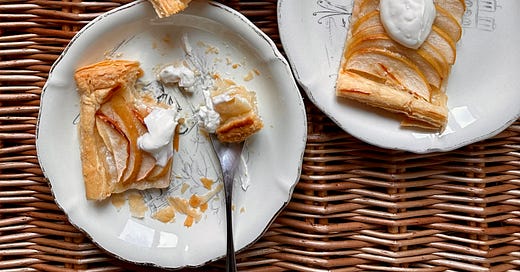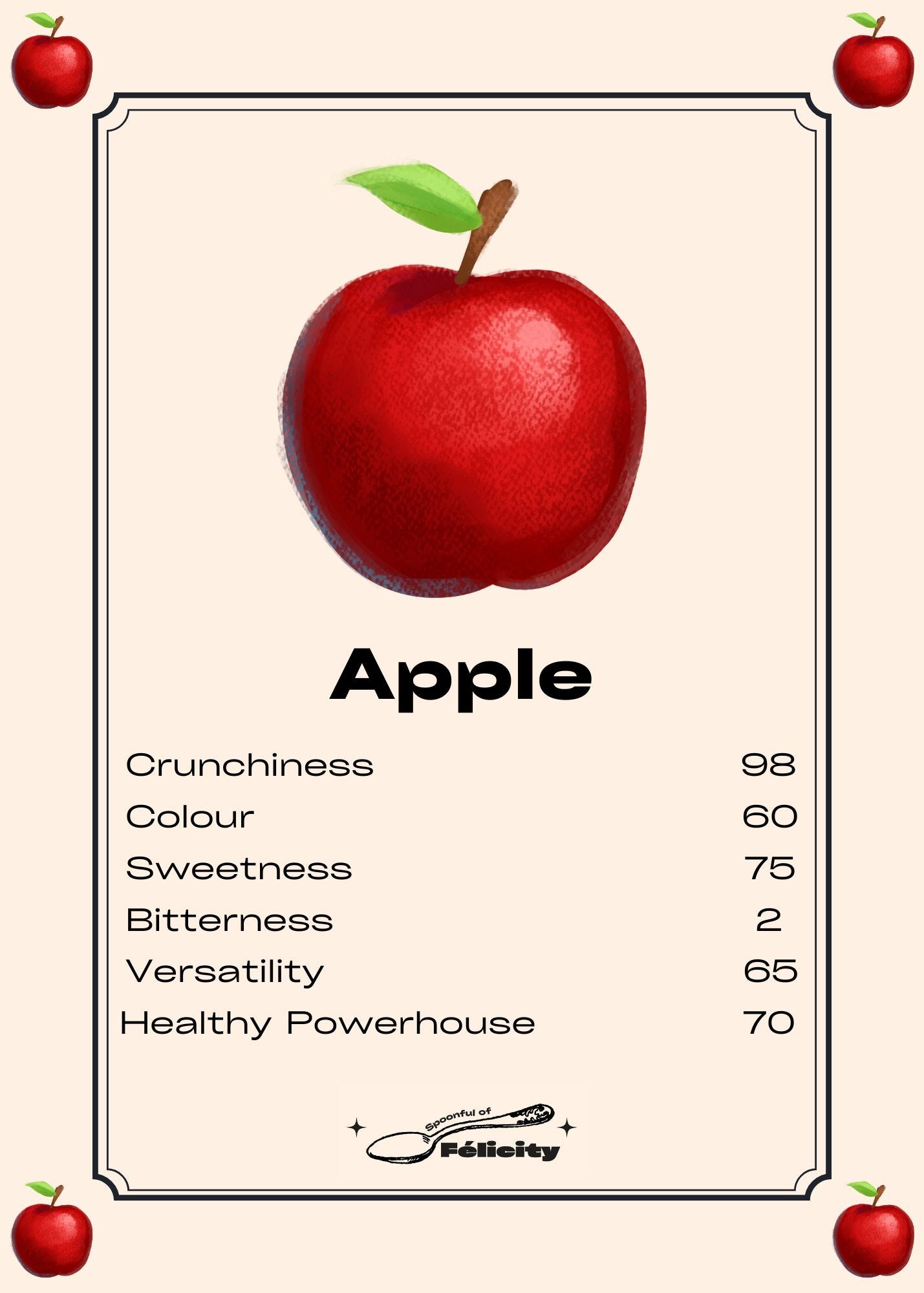January #1 - Apples and a classic french tart
Does an apple a day really keep the doctor away?
Did you know my paid subscribers also get a recipe each week featuring the spotlight ingredient?
For only £45/year, paid subscribers get access to:
A new seasonal recipe every week.
A cook along video for the recipe.
Full access to my archive of newsletters and recipes.
You can unsubscribe in one click.
HISTORY:
Apples are such a ubiquitous fruit these days that they may only come across as a boring addition to our lunch bag, most often ignored, but really they have been woven into our cultural history for thousands of years.
Was the original apple tree in the garden of Eden? More on that later, but what we do know from genomic studies is that our common apples come from a type of wild apple tree still found to this day in Kazakhstan. Birds disseminated apples across Asia, and they found themselves being picked on the silk road as a handy little snack. This is where Romans picked them up, it seems around 300BC, and started to breed them selectively to make them bigger and sweeter. They then spread these across the Empire along with their cultivation methods. Indeed, there are wild apples everywhere, and evidence they were eaten during the Neolithic age in Europe and the UK, but the modern apple we eat today comes all the way from that specific one type in Kazakhstan.
The height of breeding for cultivars we still love today was in the 19th Century, including Richard Cox’s introduction of the Cox eating apple and the Bramley’s Seedling cooking apple. The most popular varieties today around the world are the Fuji, Red Gala, Golden Delicious, Granny Smith, Braeburn, Pink Lady and Honey Crisp. It seems the general consensus is: we all love a large crisp red apple.
FUN FACTS:
So, were apples really the forbidden fruit? The original texts don’t actually specify and for a long time it was interpreted differently depending on where readers placed the garden of Eden. On his famous Sistine Chapel painting, Michelangelo actually depicted a fig. But in translations starting in the Middle Ages, apples start to become the star, either as a play on words, or a mistranslation, due to the similarity in latin between the word for apple and evil (the common apple’s name being Malus Domestica).
There are over 7,500 varieties of cultivated apples in the World, more than 2,000 in Britain alone!
Apples grown from seed will be widely different to their parent, therefore cultivated apples are grown using a method called grafting (thank you Rome!). It does mean apples vary greatly in size, texture, colour and sweetness and therefore have always had many different uses such as cider, vinegar, but also medicine and as a skin ointment. In fact that is where the french word ‘pommade’ aka skin cream comes from, as it used to be made from apples or ‘pommes’.
So, does an apple a day keep the doctor away? The saying was first used in the 1860s in Wales: ‘‘Eat an apple on going to bed, and you’ll keep the doctor from earning his bread.” A great marketing campaign. An American study tried to compare the correlation between apple eaters and visits to the doctor and found no significance, although I would say this was quite flawed and based on a 24hr diet questionnaire with the assumption people ate the same thing every day… What has been shown sufficiently however is that apples do have many health benefits including lowering cholesterol and lowering blood pressure. But they also contain a beneficial fibre called pectin which supports our gut health and in turn immune system and also their skin is rich in polyphenols which reduce the risk of developing chronic illnesses.
The apple tree in Isaac Newton’s garden which is said to have inspired his thinking on gravity, was a variety known as Flower of Kent, now very rare.
Potatoes in France are called 'pommes de terre’ or ‘apples from the earth' and I would argue that apples are indeed the potatoes of the fruit world. Thoughts?
HOW TO COOK THEM:
Nothing all that new here, I’m not trying to teach a chicken how to suck eggs, but here are some of my favourite ways with apples.
Raw:
Grated, thinly sliced or julienned into a salad.
Small dice can go into salsa and chimichurri.
Wedges are delicious dipped in hummus or almond butter.
Cooked:
Diced apple can be cooked in the microwave with a bit of water and sugar for a quick compote. Add the spices of your choice, this is then delicious added to yogurt, pancakes, porridge, overnight oats, crumble, a tart, pastry, or on top of pork.
Apple chutney can be served with cheese or as a more local alternative to mango chutney.
Apples are delicious in thin wedges on top of tarts or in cakes/muffins.
Apple skins, or thin apple slices can be dried in the oven with a dusting of cinnamon for a little snack or addition to salads.
If you cook a compote for longer, reducing it until almost all the water has evaporated, the apples darken in colour and you end up with something called apple butter. It’s delicious with cheese, spread on biscuits, used in brioche dough, or as an alternative to buttercream.
Some of my other apple recipes to try (subscribe for even more to come in the next few weeks):
Apples pair particularly well with other fruit such as pears, oranges, mangoes, pineapple, blackberries and blueberries; vegetables such as beetroot, carrot, cabbages, butternut squash, chicory/endives, rocket, celeriac and celery; nuts and in particular almonds, hazelnuts and peanuts; spices such as vanilla, rose, cinnamon, star anise, coriander seeds, clove, sage and horseradish; meat and in particular the ferrous flavour of black pudding or liver, but also pork and shellfish; and of course pretty much any cheese.
MOOD FOOD - HAPPY:
Pectin - apples feed the good bacteria in our gut, helping them thrive over the bad ones. This in turn helps to favour a happy gut-brain connection to better balance our mood.
Polyphenols - aside from known benefits to heart and cognitive health, these also fuel our gut microbiome, allowing bacteria to form tryptophan which in turn supports our serotonin levels.
This week’s recipe for paid subscribers:
French Apple Tart Recipe - Tarte fine aux pommes
A classic for a reason, this easy dessert is quick to put together and delicious.
My childhood is dotted with the fragrant comfort of apple tart. A thin crispy layer of puff pastry topped with sweet apple compote, tender apple slices and a tangy dollop of creme fraiche. It lends itself to variations with different compotes, spices and types of pastry, and you can also easily make this vegan. A great classic french dish to have in the recipe arsenal.
Ingredients (serves 6-9):
Tarte fine recipe:
1 pack of puff pastry
1 cooking apple
2 tsp honey
1 tsp vanilla extract
2 Tbs creme fraiche (and more for serving)
2 red apples
3 tsp sugar
10g butter
Method:
Preheat the oven to 180°C.
Peel and core the cooking apple, then dice it up roughly. Add it to a microwave proof dish with 50mL water and microwave on full power for 5 minutes.
Stir it with a spoon, it should fall appart into a mush, then add the honey and vanilla and mix well. Taste to make sure it doesn’t need anymore sweetness, adjust if needed. Then leave on the side to cool down.
Cut the 2 red apples into thin slices, skin still on.
Unroll the puff pastry, then outline a crust with the tip of the knife, making sure not to cut all the way through. Top the pastry with the creme fraiche and spread it across within the crust boundaries.
Then top with the compote, and finally layer the apple slices on top of each other.
Scatter the caster sugar on top, along with the butter cut up into small pieces.
Bake for 20 minutes or until the pastry is golden brown.
It’s even better served up while it's warm with a small dollop of creme fraiche. Bon appétit!
Shortcuts:
You can use shop bought apple sauce/compote. In the UK, I often find I have to go to the baby food aisle for compote haha.
I’ve arranged the apple slices neatly, but if you’re not fussed than you can just scatter them on top of course!
Keys to success:
This recipe is simple and no-fail, but feel free to pop your questions in the comments or message me and I'll be happy to help.
To make this recipe vegan, use shop-bought pastry that doesn’t have butter in it (most lower cost ones don’t) and remove the creme fraiche.





